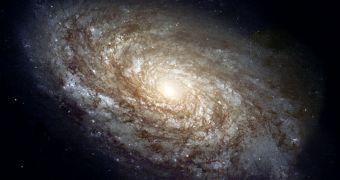Astronomers can now simulate the growth of galaxies with increased accuracy, after a team of experts figured out how to introduce a phenomenon called stellar feedback into the equation. This type of feedback occurs within every galaxy, but its role in determining their overall shape and size has been largely overlooked.
One of the most common problems with computer models seeking to simulate the development of galaxies, from the Big Bang onwards, is that results always show galaxies with more mass and stars than astronomers see in the night sky. Researchers at the California Institute of Technology (Caltech) have just figured out why this happens.
What models tend to show is that most gas in a newly-formed galaxy tends to form stars. However, in reality, only around 10 percent of all molecular hydrogen gas in galactic clouds form new stars. Additionally, only 1 percent or less of gases in massive galaxies collapse into stars.
Models that evaluate galactic evolution include factors such as gravity, gas chemistry and the evolution of the Universe, but their results are lacking. The Caltech team discovered that not including a process called stellar feedback in the measurements leads to corrupt conclusions.
According to Dr. Philip Hopkins, an astronomer at Caltech, all stars affect their galactic surroundings to a great extent. For example, when the celestial fireballs form, they release massive amounts of radiation and solar winds that push nearby gases away, disrupting stellar formation in their vicinity.
When massive stars die in a galaxy – in massive supernova blasts – these incredibly powerful explosions can accelerate nearby gas clouds to near-sonic speeds, making it impossible for other stars to appear within several light-years of their location.
When they incorporated these data into their FIRE (Feedback in Realistic Environments) project, Caltech investigators found that the results were far more in tune with observable reality. The group also included a realistic supernovae rate in their latest computer simulations.
“The result is that we see these stars pushing on the gas, and supernovae explosions sweeping up and ‘blowing out’ large amounts of material from galaxies,” Hopkins says, quoted by Universe Today.
“When you follow all of this, the story holds together, and indeed we can explain the observed masses of galaxies just from the input of stars,” the expert concludes.

 14 DAY TRIAL //
14 DAY TRIAL //